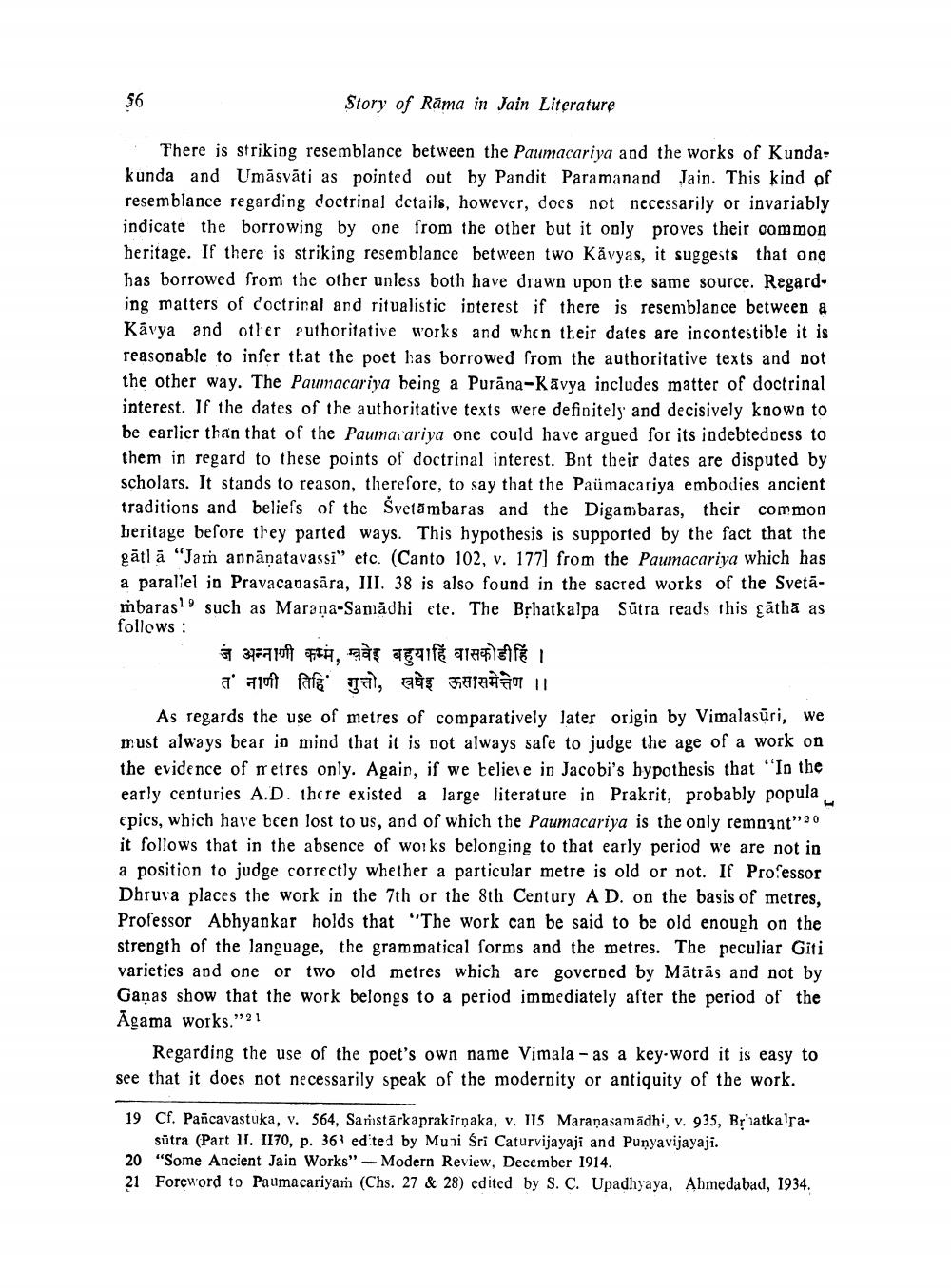________________
Story of Rāma in Jain Literature
There is striking resemblance between the Paumacariya and the works of Kundakunda and Umāsvāti as pointed out by Pandit Paramanand Jain. This kind of resemblance regarding doctrinal details, however, does not necessarily or invariably indicate the borrowing by one from the other but it only proves their common heritage. If there is striking resemblance between two Kävyas, it suggests that one has borrowed from the other unless both have drawn upon the same source. Regard. ing matters of doctrinal and ritualistic interest if there is resemblance between a Kävya and other puthoritative works and when their dates are incontestible it is reasonable to infer that the poet has borrowed from the authoritative texts and not the other way. The Paumacariya being a Purāna-Kavya includes matter of doctrinal interest. If the dates of the authoritative texts were definitely and decisively known to be earlier than that of the Pauma ariya one could have argued for its indebtedness to them in regard to these points of doctrinal interest. Bnt their dates are disputed by scholars. It stands to reason, therefore, to say that the Paümacariya embodies ancient traditions and beliefs of the Svetămbaras and the Digambaras, their common heritage before they parted ways. This hypothesis is supported by the fact that the gātlā "Jam annāņatavassi" etc. (Canto 102, v. 177] from the Paumacariya which has a parallel in Pravacapasāra, III. 38 is also found in the sacred works of the Svetāmbarasl' such as Marana-Samădhi ete. The BỊhatkalpa Sūtra reads this gātha as follows:
जं अन्नाणी कम्म, ग्ववेइ बहुयाहिं वासकोडीहिं ।
त नाणी तिहि गुत्तो, खघेइ ऊसासमेत्तेण ।। As regards the use of metres of comparatively later origin by Vimalasūri, we must always bear in mind that it is not always safe to judge the age of a work on the evidence of retres only. Again, if we believe in Jacobi's hypothesis that “In the early centuries A.D. there existed a large literature in Prakrit, probably popula epics, which have been lost to us, and of which the Paumacariya is the only remnant”20 it follows that in the absence of works belonging to that early period we are not in a position to judge correctly whether a particular metre is old or not. If Professor Dhruva places the work in the 7th or the 8th Century AD. on the basis of metres, Professor Abhyankar holds that "The work can be said to be old enough on the strength of the language, the grammatical forms and the metres. The peculiar Giti varieties and one or two old metres which are governed by Mātrās and not by Ganas show that the work belongs to a period immediately after the period of the Agama works."21
Regarding the use of the poet's own name Vimala - as a key-word it is easy to see that it does not necessarily speak of the modernity or antiquity of the work.
19 Cf. Pancavastuka, v. 564, Saristārkaprakirņaka, v. 115 Maranasamadhi, v. 935, Bţiatkalsa
sūtra (Part 11. 1170, p. 361 edited by Muni Sri Caturvijayaji and Punyavijayaji. 20 "Some Ancient Jain Works" - Modern Review, December 1914. 21 Foreword to Paumacariyam (Chs. 27 & 28) edited by S. C. Upadhyaya, Ahmedabad, 1934.




